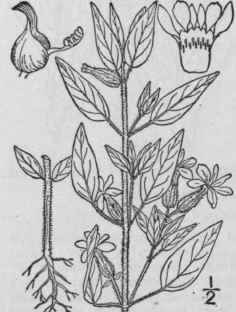6. Parsonsia P. Br.; Adans. Fam. Pl. 2: 234. 1763. [Cuphea P Br.; Adans. Loc. Cit. Hyponym. 1763.]
Description
This section is from the book "An Illustrated Flora Of The Northern United States, Canada And The British Possessions Vol2", by Nathaniel Lord Britton, Addison Brown. Also available from Amazon: An Illustrated Flora of the Northern United States, Canada and the British Possessions. 3 Volume Set..
6. Parsonsia P. Br.; Adans. Fam. Pl. 2: 234. 1763. [Cuphea P Br.; Adans. Loc. Cit. Hyponym. 1763.]
Herbs (some shrubs in tropical regions), with opposite or verticillate leaves. Flowers solitary or racemose, axillary, irregular and unsymmetrical. Calyx-tube elongated, tubular, 12-ribbeu, gibbous or spurred at the base, oblique at the mouth with 6 primary teeth and usually as many appendanges. Petals 6, unequal. Stamens mostly 11 (sometimes 12 m our species), inserted on the throat of the calyx, unequal; filaments short. Ovary sessile or obliquely stipitate, with a curved gland at its base, unequally 2-celled; ovules several or numerous; style slender; stigma 2-lobed. Capsule included in the calyx, oblong, 1-celled, laterally dehiscent. Seeds flattened. [In honor of James Parsons, M. D., a Scotch botanist.]'
About 200 species, natives of America. Besides the following, 2 others occur in the Southern States. Type species: Lythrum Parsonsia L.

1. Parsonsia Petioląta (L.) Rusby. Blue Wax-Weed. Clammy Cuphea. Tar-Weed. Wax-Bush
Fig. 3008
Lythrum petiolatum L. Sp. Pl. 446. 1753.
Cuphea viscosissima Jacq. Hort. Vind. 2: 83 pl. 177. 1772.
Cuphea petiolata Koehne, Engler's Bot. Jahrb. 2: 173. 1882.
Not Pohl. Parsonsia petiolata Rusby, Mem. Torr. Club 5: 231. 1894.
Annual, erect, very viscid-pubescent, branched, 6-20' high. Leaves slender-petioled, ovate-lanceolate, scabrous, mostly rounded at the base and blunt-pointed at the apex, 1'-1 1/2' long; flowers axillary, short-peduncled, purple, 3"-4" broad; petals ovate, clawed; stamens sometimes 12; fruiting calyx swollen, about 4" long; capsule dehiscent before the seeds are ripe, the placenta projecting through the lateral orifice.
In dry soil, New Hampshire to northern Illinois and Kansas, south to Georgia and Louisiana. Introduced into southern Ontario. Ascends to 3300 ft. in West Virginia. July-Oct.
Continue to:


